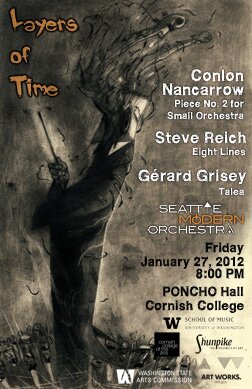The performance took place Friday night, and was preceded by the Chaopraya Ensemble celebrating Thai culture, the Kalahi Philippine Dance Company, a Heritage Dress Parade celebrating the diversity of Asian fashion, and even Kung Fu, plus, after the performance, One World Taiko, drumming us to dance our way out of Benaroya Hall. Many of the women in the audience also wore traditional dress, making it strikingly bright and varied.
The performance itself, directed by the dynamic young Taiwanese conductor Julia Tai, included two world premieres: Nam Mai by Richard Karpen, with The Six Tones, a group of three musicians bringing together music of Vietnam and the West using traditional Vietnamese instruments, plus members of the Seattle Symphony; and a purely orchestral work, the Overture to The Siege by Shuying Li. These were bracketed at start and finish by Toru Takemitsu’s Three Film Scores for string orchestra, and the Concerto in A Minor by Grieg with Chinese pianist Haochen Zhang, the only work in which the music had no Asian context.
Karpen’s work was most interesting for the instruments used by The Six Tones and their skilled performers: Nguyen Thanh Thuy playing the dan tranh, a Vietnamese zither, kin to the Japanese koto in appearance and somewhat twangy and edgy in tone; Ngo Tra My, playing the dan bau, an ancient single-stringed instrument on which the pitch of the string can be changed, each note varied further by movement of a vertical rod and with a pure bell-like tone; and Sweden’s Stefan Osterjo, playing the ti ba, a lutelike instrument similar to the Chinese pipa, and also the Vietnamese guitar. These are beautiful instruments and a joy to hear.
Karpen, a UW professor, has collaborated with this group for some years and excerpts from their Vietnamese dance film project were shown simultaneously with the music and with Nguyen dressing like the film and dancing across the stage. Nineteen string players of the Seattle Symphony acted as background music in an arc behind the soloists. Unfortunately both music and film clips seemed more chaotic than coherent, and it went on too long.
Far more exciting musically was the overture by young composer Shuying Li. Her 8-minute work showed plenty of musical ideas well realized, considerable skill in orchestration and a flair for using different instruments and techniques to create orchestral color. It ignited in this listener keen interest to hear more of her music, including the opera for which this is intended as overture.
The Three Film Scores of Takemitsu, Japan’s eminent composer of the 20th century, show considerable Western influence, but also unmistakably his historic background. Exciting, the first jazzy with a feel of Gershwin but different harmonies, the next discordant, uncomfortable and restless, the third a Western waltz, each mirrored the movie story for which they were written. Not all movie music works well without the movie, but these do, having shape and intention.
Lastly came Grieg’s famous and familiar piano concerto. Young pianist Haochen Zhang has the technique in his fingers, but I would have liked to hear more nuance in his performance. His quiet passages were beautiful as his relaxed hands let the music flow easily and with shape, but he seemed to have little between that dynamic and double or triple fortes in which his hands became almost claws. There was too much bombast in this performance along with beautiful lyricism at times.
Conductor Tai, who conducts Seattle Modern Orchestra, did an excellent job of introducing the music to an audience which might not be so familiar with orchestral works, and she is skilled and effective at directing.
{Correction: a commenter noted, albeit impolitely and more than once, that our review of the performance of The Siege, led by composer Shuying Li, incorrectly noted the presence of a baritone sax. After checking with the Seattle Symphony, we learned that there was indeed no baritone sax and the production notes we were given incorrectly listed its inclusion and believe it was a last-minute change. We regret and apologize for the error and have removed it from the text above.}
